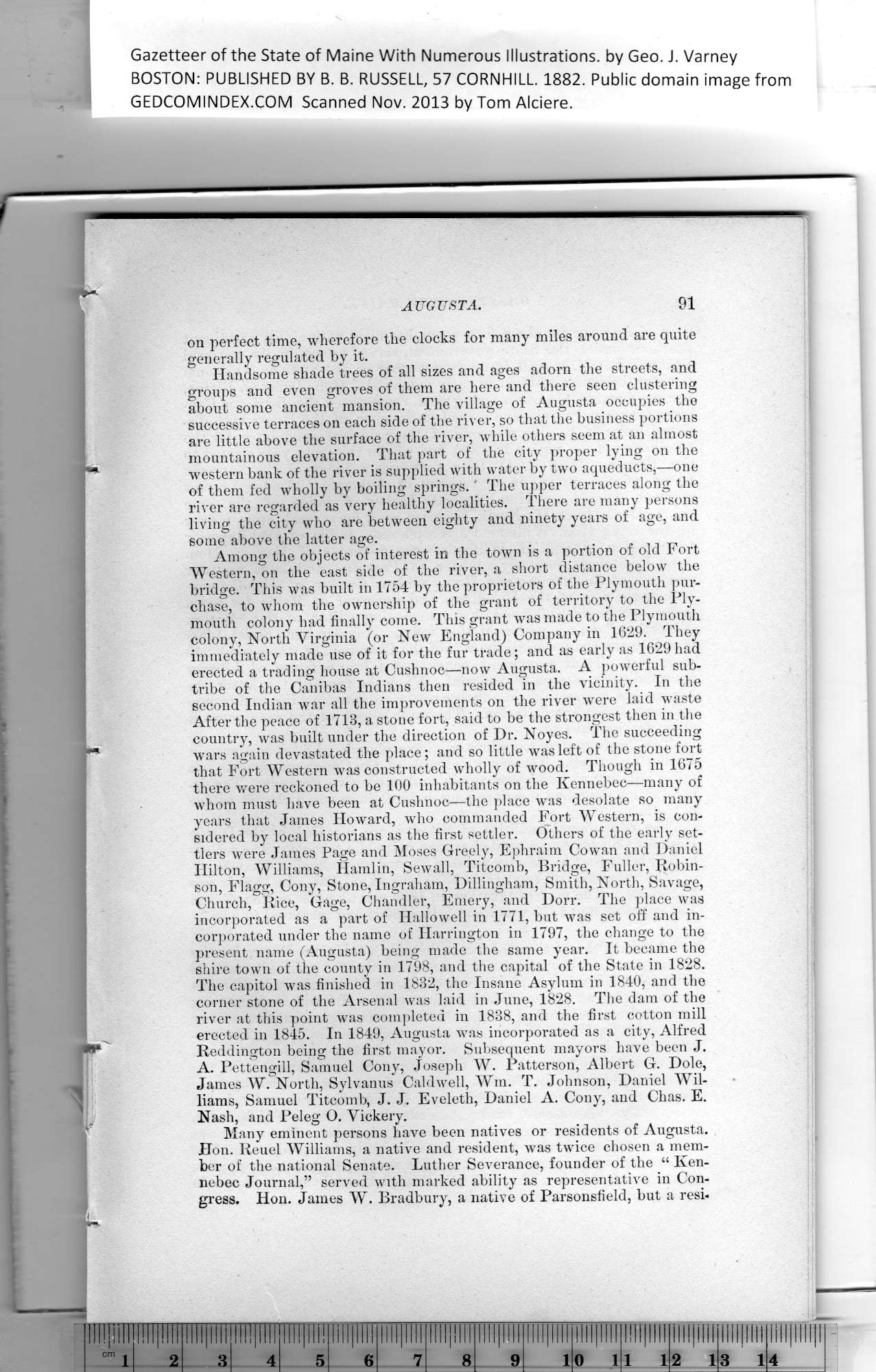|
Gazetteer of the State of Maine With Numerous Illustrations, by Geo. J. Varney
BOSTON. PUBLISHED BY B. B. RUSSELL, 57 CORNHILL. 1882. Public domain image from
AUGUSTA.
on perfect time, wherefore the clocks for many miles around are quite
generally regulated by it.
Handsome shade trees of all sizes and ages adorn the streets, and
groups and even groves of them are here and there seen clustering
about some ancient mansion. The village of Augusta occupies the
successive terraces on each side of the river, so that the business portions
are little above the surface of the river, while others seem at an almost
mountainous elevation. That part of the city proper lying on the
western bank of the river is supplied with water by two aqueducts,—one
of them fed wholly by boiling springs. The upper terraces along the
river are regarded as very healthy localities. There are many persons
living the city who are between eighty and ninety years of age, and
some above the latter age.
Among the objects of interest in the town is a portion of old Fort
Western, on the east side of the river, a short distance below the
bridge. This was built in 1754 by the proprietors of the Plymouth pur-
chase, to whom the ownership of the grant of territory to the Ply-
mouth colony had finally come. This grant was made to the Plymouth
colony, North Virginia (or New England) Company in 1629. They
immediately made use of it for the fur trade; and as early as 1629 had
erected a trading house at Cushnoc—now Augusta. A. powerful sub-
tribe of the Canibas Indians then resided in the vicinity. In the
second Indian war all the improvements on the river were laid waste
After the peace of 1713, a stone fort, said to be the strongest then in the
country, was built under the direction of Dr. Noyes. The succeeding
wars again devastated the place; and so little was left of the stone fort
that Fort Western was constructed wholly of wood. Though in 1675
there were reckoned to be 100 inhabitants on the Kennebec—many of
whom must have been at Cushnoc—the place was desolate so many
years that James Howard, who commanded Fort Western, is con-
sidered by local historians as the first settler. Others of the early set-
tlers were James Page and Moses Greely, Ephraim Cowan and Daniel
Hilton, Williams, Hamlin, Sewall, Titcomb, Bridge, Fuller, Robin-
son, Flagg, Cony, Stone, Ingraham, Dillingham, Smith, North, Savage,
Church, Rice, Gage, Chandler, Emery, and Dorr. The place was
incorporated as a part of Hallo well in 1771, but was set off and in-
corporated under tbe name of Harrington in 1797, the change to the
present name (Augusta) being made the same year. It became the
shire town of the county in 1798, and the capital of the State in 1828.
The capitol was finished in 1832, the Insane Asylum in 1840, and the
corner stone of the Arsenal was laid in June, 1828. The dam of the
river at this point was completed in 1838, and the first cotton mill
erected in 1845. In 1849, Augusta was incorporated as a city, Alfred
Reddington being the first mayor. Subsequent mayors have been J.
A. Pettengill, Samuel Cony, Joseph W. Patterson, Albert G. Dole,
James W. North, Sylvanus Caldwell, Wm. T. Johnson, Daniel Wil-
liams, Samuel Titcomb, J. J. Eveleth, Daniel A. Cony, and Chas. E.
Nash, and Peleg O. Vickery.
Many eminent persons have been natives or residents of Augusta.
Hon. Reuel Williams, a native and resident, was twice chosen a mem-
ber of the national Senate. Luther Severance, founder of the “ Ken-
nebec Journal,” served with marked ability as representative in Con-
gress. Hon. James W. Bradbury, a native of Parsonsfield, but a resi-
V'
PREVIOUS PAGE ... NEXT PAGE
This page was written in HTML using a program written in Python 3.2
|
